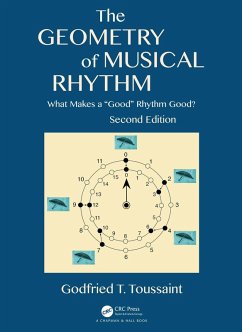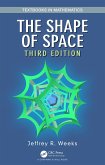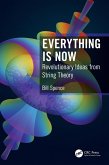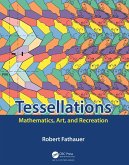Godfried T. Toussaint
The Geometry of Musical Rhythm (eBook, PDF)
What Makes a "Good" Rhythm Good?, Second Edition
51,95 €
51,95 €
inkl. MwSt.
Sofort per Download lieferbar

26 °P sammeln
51,95 €
Als Download kaufen

51,95 €
inkl. MwSt.
Sofort per Download lieferbar

26 °P sammeln
Jetzt verschenken
Alle Infos zum eBook verschenken
51,95 €
inkl. MwSt.
Sofort per Download lieferbar
Alle Infos zum eBook verschenken

26 °P sammeln
Godfried T. Toussaint
The Geometry of Musical Rhythm (eBook, PDF)
What Makes a "Good" Rhythm Good?, Second Edition
- Format: PDF
- Merkliste
- Auf die Merkliste
- Bewerten Bewerten
- Teilen
- Produkt teilen
- Produkterinnerung
- Produkterinnerung

Bitte loggen Sie sich zunächst in Ihr Kundenkonto ein oder registrieren Sie sich bei
bücher.de, um das eBook-Abo tolino select nutzen zu können.
Hier können Sie sich einloggen
Hier können Sie sich einloggen
Sie sind bereits eingeloggt. Klicken Sie auf 2. tolino select Abo, um fortzufahren.

Bitte loggen Sie sich zunächst in Ihr Kundenkonto ein oder registrieren Sie sich bei bücher.de, um das eBook-Abo tolino select nutzen zu können.
The original edition of The Geometry of Musical Rhythm was the first book to provide a systematic and accessible computational geometric analysis of the musical rhythms of the world. It explained how the study of the mathematical properties of musical rhythm generates common mathematical problems that arise in seemingly disparate fields.
- Geräte: PC
- ohne Kopierschutz
- eBook Hilfe
- Größe: 23.55MB
Andere Kunden interessierten sich auch für
![Curved-Folding Origami Design (eBook, PDF) Curved-Folding Origami Design (eBook, PDF)]() Jun MitaniCurved-Folding Origami Design (eBook, PDF)38,95 €
Jun MitaniCurved-Folding Origami Design (eBook, PDF)38,95 €![Crocheting Adventures with Hyperbolic Planes (eBook, PDF) Crocheting Adventures with Hyperbolic Planes (eBook, PDF)]() Daina TaiminaCrocheting Adventures with Hyperbolic Planes (eBook, PDF)26,95 €
Daina TaiminaCrocheting Adventures with Hyperbolic Planes (eBook, PDF)26,95 €![The Shape of Space (eBook, PDF) The Shape of Space (eBook, PDF)]() Jeffrey R. WeeksThe Shape of Space (eBook, PDF)51,95 €
Jeffrey R. WeeksThe Shape of Space (eBook, PDF)51,95 €![Six Simple Twists (eBook, PDF) Six Simple Twists (eBook, PDF)]() Benjamin Dileonardo-ParkerSix Simple Twists (eBook, PDF)37,95 €
Benjamin Dileonardo-ParkerSix Simple Twists (eBook, PDF)37,95 €![Quaternion and Clifford Fourier Transforms (eBook, PDF) Quaternion and Clifford Fourier Transforms (eBook, PDF)]() Eckhard HitzerQuaternion and Clifford Fourier Transforms (eBook, PDF)46,95 €
Eckhard HitzerQuaternion and Clifford Fourier Transforms (eBook, PDF)46,95 €![Everything is Now (eBook, PDF) Everything is Now (eBook, PDF)]() Bill SpenceEverything is Now (eBook, PDF)20,95 €
Bill SpenceEverything is Now (eBook, PDF)20,95 €![Tessellations (eBook, PDF) Tessellations (eBook, PDF)]() Robert FathauerTessellations (eBook, PDF)51,95 €
Robert FathauerTessellations (eBook, PDF)51,95 €-
-
-
The original edition of The Geometry of Musical Rhythm was the first book to provide a systematic and accessible computational geometric analysis of the musical rhythms of the world. It explained how the study of the mathematical properties of musical rhythm generates common mathematical problems that arise in seemingly disparate fields.
Dieser Download kann aus rechtlichen Gründen nur mit Rechnungsadresse in A, B, BG, CY, CZ, D, DK, EW, E, FIN, F, GR, HR, H, IRL, I, LT, L, LR, M, NL, PL, P, R, S, SLO, SK ausgeliefert werden.
Produktdetails
- Produktdetails
- Verlag: Taylor & Francis
- Seitenzahl: 370
- Erscheinungstermin: 25. November 2019
- Englisch
- ISBN-13: 9781351247764
- Artikelnr.: 58303741
- Verlag: Taylor & Francis
- Seitenzahl: 370
- Erscheinungstermin: 25. November 2019
- Englisch
- ISBN-13: 9781351247764
- Artikelnr.: 58303741
Godfried T. Toussaint is a Canadian computer scientist born in Belgium. Presently, he is a Research Professor of Computer Science at the University of New York, Abu Dhabi, United Arab Emirates, a Research Affiliate at the Massachusetts Institute of Technology in the Computer Science and Artificial Intelligence Laboratory, a Researcher in the Center for Interdisciplinary Research in Music Media and Technology (CIRMMT) in the Schulich School of Music at McGill University, and an Emeritus Professor of Computer Science at McGill. After receiving a PhD in electrical engineering from the University of British Columbia in Vancouver, Canada, he taught and did research at the School of Computer Science at McGill University, in the areas of information theory, pattern recognition, pattern analysis and design, computational geometry, instance-based learning, music information retrieval, and computational music theory. In 1978, he received the Pattern Recognition Society's Best Paper of the Year Award and in 1985 he was awarded a Senior Killam Research Fellowship by the Canada Council. In May 2001, he was awarded the David Thomson Award for excellence in graduate supervision and teaching at McGill University. He is a founder and cofounder of several international conferences and workshops on computational geometry. He is an editor of several journals, has appeared on television programs to explain his research on the mathematical analysis of flamenco rhythms, and has published more than 360 papers. In 2009, he was awarded a Radcliffe Fellowship by the Radcliffe Institute for Advanced Study at Harvard University, for the 2009-2010 academic year, to carry out a research project on the phylogenetic analysis of the musical rhythms of the world. After spending an additional year at Harvard University, in the music department, he moved in August 2011 to New York University in Abu Dhabi.
What Is Rhythm?. A Steady Beat. Timelines, Ostinatos, and Meter. The Wooden
Claves. The Iron Bells. The Clave Son. Six Distinguished Rhythm Timelines.
The Distance Geometry of Rhythm. Classification of Rhythms. Binary and
Ternary Rhythms. The Isomorphism of Rhythm and Scale. Binarization,
Ternarization, and Quantization of Rhythms. Syncopated Rhythms. Necklaces
and Bracelets. Rhythmic Oddity. Off-Beat Rhythms. Rhythm Complexity.
Dispersion Problems and Maximally Even Rhythms. Euclidean Rhythms. Leap
Years: The Rhythm of the Stars. Approximately Even Rhythms. Rhythms and
Crystallography. Complementary Rhythms. Radio Astronomy and Flat Rhythms.
Deep Rhythms. Shelling Rhythms. Phantom Rhythms. Reflection Rhythms and
Rhythmic Canons. Toggle Rhythms. Symmetric Rhythms. Odd Rhythms. Other
Representations of Rhythm. Rhythmic Similarity and Dissimilarity. Regular
and Irregular Rhythms. Evolution and Phylogenesis of Musical Rhythm.
Rhythmic Combinatorics. What Makes the Clave Son Such a Good Rhythm?. The
Origin, Evolution, and Migration of the Clave Son. Epilogue. References.
Index.
Claves. The Iron Bells. The Clave Son. Six Distinguished Rhythm Timelines.
The Distance Geometry of Rhythm. Classification of Rhythms. Binary and
Ternary Rhythms. The Isomorphism of Rhythm and Scale. Binarization,
Ternarization, and Quantization of Rhythms. Syncopated Rhythms. Necklaces
and Bracelets. Rhythmic Oddity. Off-Beat Rhythms. Rhythm Complexity.
Dispersion Problems and Maximally Even Rhythms. Euclidean Rhythms. Leap
Years: The Rhythm of the Stars. Approximately Even Rhythms. Rhythms and
Crystallography. Complementary Rhythms. Radio Astronomy and Flat Rhythms.
Deep Rhythms. Shelling Rhythms. Phantom Rhythms. Reflection Rhythms and
Rhythmic Canons. Toggle Rhythms. Symmetric Rhythms. Odd Rhythms. Other
Representations of Rhythm. Rhythmic Similarity and Dissimilarity. Regular
and Irregular Rhythms. Evolution and Phylogenesis of Musical Rhythm.
Rhythmic Combinatorics. What Makes the Clave Son Such a Good Rhythm?. The
Origin, Evolution, and Migration of the Clave Son. Epilogue. References.
Index.
What Is Rhythm?. A Steady Beat. Timelines, Ostinatos, and Meter. The Wooden
Claves. The Iron Bells. The Clave Son. Six Distinguished Rhythm Timelines.
The Distance Geometry of Rhythm. Classification of Rhythms. Binary and
Ternary Rhythms. The Isomorphism of Rhythm and Scale. Binarization,
Ternarization, and Quantization of Rhythms. Syncopated Rhythms. Necklaces
and Bracelets. Rhythmic Oddity. Off-Beat Rhythms. Rhythm Complexity.
Dispersion Problems and Maximally Even Rhythms. Euclidean Rhythms. Leap
Years: The Rhythm of the Stars. Approximately Even Rhythms. Rhythms and
Crystallography. Complementary Rhythms. Radio Astronomy and Flat Rhythms.
Deep Rhythms. Shelling Rhythms. Phantom Rhythms. Reflection Rhythms and
Rhythmic Canons. Toggle Rhythms. Symmetric Rhythms. Odd Rhythms. Other
Representations of Rhythm. Rhythmic Similarity and Dissimilarity. Regular
and Irregular Rhythms. Evolution and Phylogenesis of Musical Rhythm.
Rhythmic Combinatorics. What Makes the Clave Son Such a Good Rhythm?. The
Origin, Evolution, and Migration of the Clave Son. Epilogue. References.
Index.
Claves. The Iron Bells. The Clave Son. Six Distinguished Rhythm Timelines.
The Distance Geometry of Rhythm. Classification of Rhythms. Binary and
Ternary Rhythms. The Isomorphism of Rhythm and Scale. Binarization,
Ternarization, and Quantization of Rhythms. Syncopated Rhythms. Necklaces
and Bracelets. Rhythmic Oddity. Off-Beat Rhythms. Rhythm Complexity.
Dispersion Problems and Maximally Even Rhythms. Euclidean Rhythms. Leap
Years: The Rhythm of the Stars. Approximately Even Rhythms. Rhythms and
Crystallography. Complementary Rhythms. Radio Astronomy and Flat Rhythms.
Deep Rhythms. Shelling Rhythms. Phantom Rhythms. Reflection Rhythms and
Rhythmic Canons. Toggle Rhythms. Symmetric Rhythms. Odd Rhythms. Other
Representations of Rhythm. Rhythmic Similarity and Dissimilarity. Regular
and Irregular Rhythms. Evolution and Phylogenesis of Musical Rhythm.
Rhythmic Combinatorics. What Makes the Clave Son Such a Good Rhythm?. The
Origin, Evolution, and Migration of the Clave Son. Epilogue. References.
Index.







